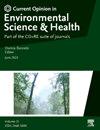Understanding the pathways, pollution and potential solutions pertaining to pesticides: Circular engineering for persistent chemicals
IF 6.6
Q1 ENVIRONMENTAL SCIENCES
Current Opinion in Environmental Science and Health
Pub Date : 2025-06-09
DOI:10.1016/j.coesh.2025.100638
引用次数: 0
Abstract
This paper offers a comprehensive examination of the global footprint of pesticides consumption, revealing the disproportionate usage in high-income countries and highlighting the severe environmental and health risks posed by chemicals such as organochlorines and organophosphates. While numerous studies have been conducted on assessing the fate and transport of pesticides in the natural environment in developed nations, however, there is pressing need for similar research in developing regions, within South-East Asia, Latin America, and the African Union. Due to the cumulative nature of pesticides and the duration of exposure, it was expected that biota would show higher average, minimum, and maximum concentrations, along with increased variability. Water appears to be slightly more contaminated than sediment, but the most concerning revelation is the prevalence of pesticides in the air. Emphasizing the urgency of sustainable practices, the paper proposes microcosmic understanding on the degradation of pesticides, their contribution to antimicrobial resistance, and the development of environmentally friendly alternatives.
了解与农药有关的途径、污染和潜在解决方案:持久性化学品的循环工程
本文全面考察了农药消费的全球足迹,揭示了高收入国家不成比例的使用情况,并强调了有机氯和有机磷等化学品造成的严重环境和健康风险。虽然已经进行了许多关于评估发达国家自然环境中农药的命运和运输的研究,但是,迫切需要在东南亚、拉丁美洲和非洲联盟的发展中地区进行类似的研究。由于农药的累积性质和暴露时间,预计生物群将显示更高的平均、最低和最高浓度,同时变异性也会增加。水的污染程度似乎比沉积物稍高,但最令人担忧的是空气中农药的普遍存在。强调可持续实践的紧迫性,本文提出了对农药降解的微观认识,它们对抗菌素耐药性的贡献,以及开发环境友好的替代品。
本文章由计算机程序翻译,如有差异,请以英文原文为准。
求助全文
约1分钟内获得全文
求助全文
来源期刊

Current Opinion in Environmental Science and Health
Medicine-Public Health, Environmental and Occupational Health
CiteScore
14.90
自引率
0.00%
发文量
92
审稿时长
114 days
 求助内容:
求助内容: 应助结果提醒方式:
应助结果提醒方式:


